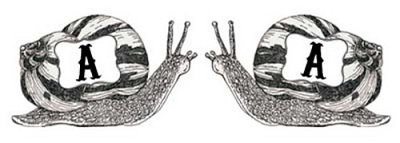Snail Mail
 On the 26th October, 1850, the same year as the first Dover to Calais submarine cable, an article appeared on the front page of the French newspaper La Presse. The author, Jules Allix, reported with much excitement on an invention which he asserted would change the world (Allix, 1850). The invention was made by a Monsieur Jacques Toussaint Benoit and was for a method of instantaneous communication over distance without the use of wires. Benoit claimed that with his revolutionary apparatus he was able to communicate directly between Paris and New York. The transmitting equipment – described as the Sympathetic-pasilalinic Compass[1] – was a large wooden frame in which was suspended a rotating disc. Twenty-six small zinc bowls were carefully set into this disc. The bowls were lined with linen soaked in a solution of copper-sulphate and each bowl was marked with a letter of the alphabet. The receiver was a copy of the transmitter. To facilitate communication, pairs of snails were encouraged to form a ‘sympathetic bond’ before being glued into the paired, alphabetised bowls in the transmitter and receiver. The pair of snails would then be ‘linked’ for life whatever the distance between the transmitter and receiver. To transmit a message, for example the letter ‘A’, the sender would poke the snail in the transmitting bowl marked ‘A’. The corresponding snail in the ‘A’ bowl of the receiver would then react by withdrawing or waving its antenna. The medium of transmission was stated to be ‘escargotic fluid’ (Allix, 1850). No archaeological remains of this groundbreaking discovery are thought to survive.
On the 26th October, 1850, the same year as the first Dover to Calais submarine cable, an article appeared on the front page of the French newspaper La Presse. The author, Jules Allix, reported with much excitement on an invention which he asserted would change the world (Allix, 1850). The invention was made by a Monsieur Jacques Toussaint Benoit and was for a method of instantaneous communication over distance without the use of wires. Benoit claimed that with his revolutionary apparatus he was able to communicate directly between Paris and New York. The transmitting equipment – described as the Sympathetic-pasilalinic Compass[1] – was a large wooden frame in which was suspended a rotating disc. Twenty-six small zinc bowls were carefully set into this disc. The bowls were lined with linen soaked in a solution of copper-sulphate and each bowl was marked with a letter of the alphabet. The receiver was a copy of the transmitter. To facilitate communication, pairs of snails were encouraged to form a ‘sympathetic bond’ before being glued into the paired, alphabetised bowls in the transmitter and receiver. The pair of snails would then be ‘linked’ for life whatever the distance between the transmitter and receiver. To transmit a message, for example the letter ‘A’, the sender would poke the snail in the transmitting bowl marked ‘A’. The corresponding snail in the ‘A’ bowl of the receiver would then react by withdrawing or waving its antenna. The medium of transmission was stated to be ‘escargotic fluid’ (Allix, 1850). No archaeological remains of this groundbreaking discovery are thought to survive.
Benoit’s idea of instantaneous ‘snail mail’ might sound more than a little silly to twenty-first-century ears but his experiments were grounded in two respectable theories of the time. The first, Franz Mesmer’s late 18th-Century concept of ‘animal magnetism’, proposed to exist as an invisible magnetic fluid, a life-force flowing through and pervading all living things (Mesmer, 1997 [1779]). The second was that of ‘galvanism’ and Alessandro Volta’s understanding of electrical action within the body (Munro, 1902). Mesmer’s ideas, although popular at the time (inspiring among other things, dynamic psychology and Mary Shelley’s Frankenstein), were later consigned to the lunatic fringes, his name forever associated with stage hypnotism. Volta’s work, however, is appreciated today as one of the foundation stones of electrical engineering, giving us the ‘volt’ as a unit of measurement as well as the ‘voltaic cell’, or battery. The Sympathetic-pasilalinic Compass is cited here to serve as an example of the mid nineteenth-century desire for communication over distance. This desire was intense and manifested itself in many unlikely sounding investigations. It was not, at the time, dismissed out of hand as we would with the benefit of hindsight. It should be remembered that the early electrical experiments which finally resulted in successful telecommunications were very much part of the same experimental tradition as Monsieur Benoit and his snails.
[1] Boussole pasilalinique sympathetique
Allix, J (1850, 26 Oct). Communication Universelle: Et instantanée de la pensée, a quel-que distance que ce soit, a l’aide d’un apparell portatif appelé Boussole pasilalinique sympathetique. La Presse (pp. 1).
